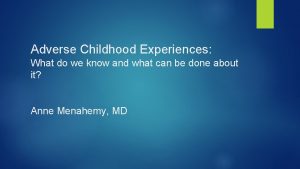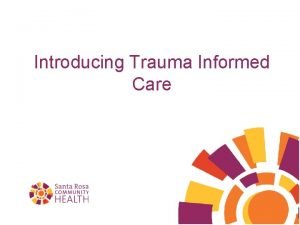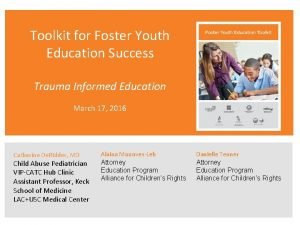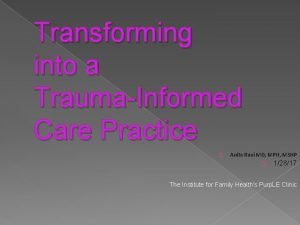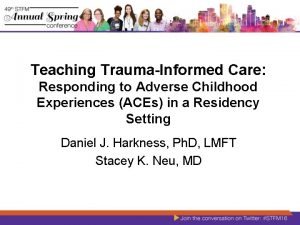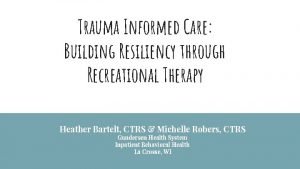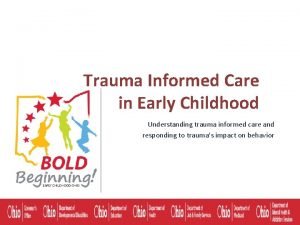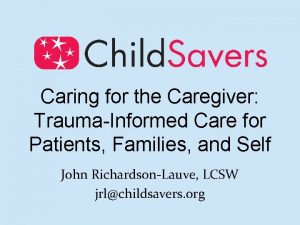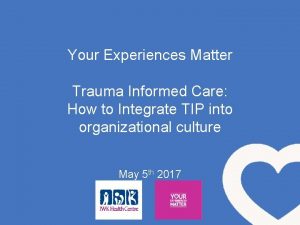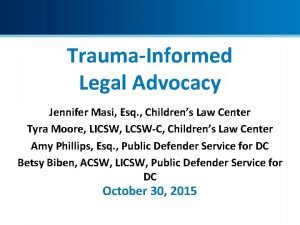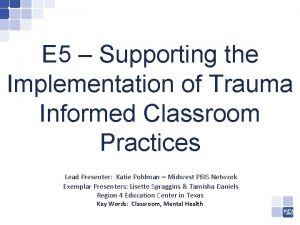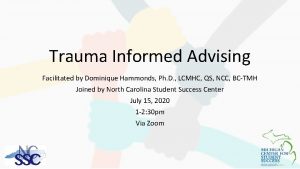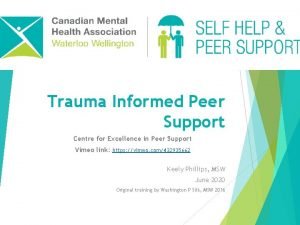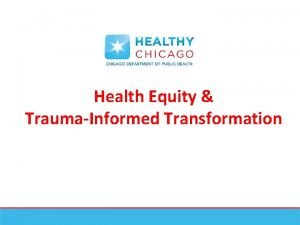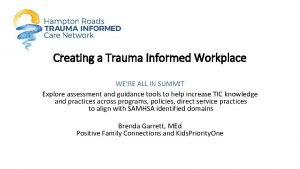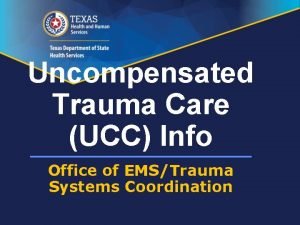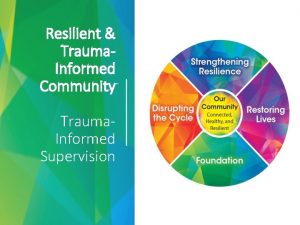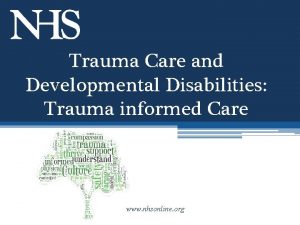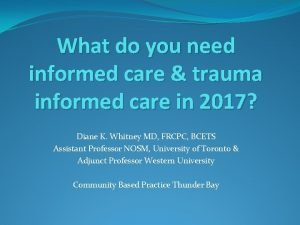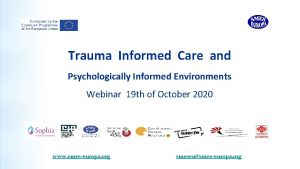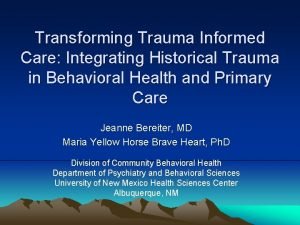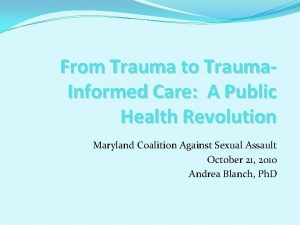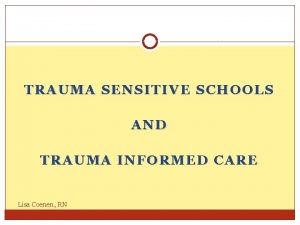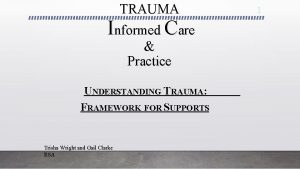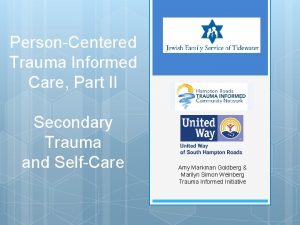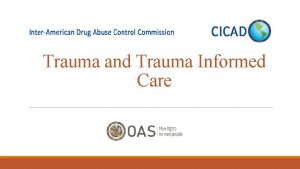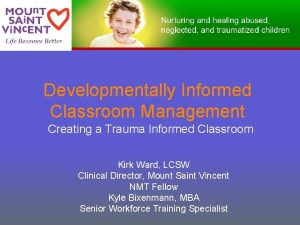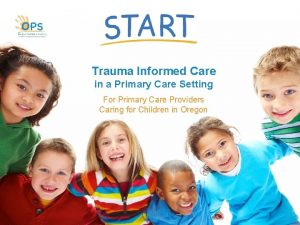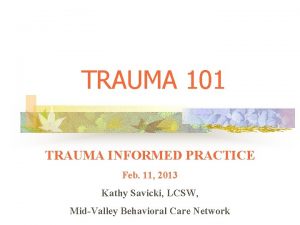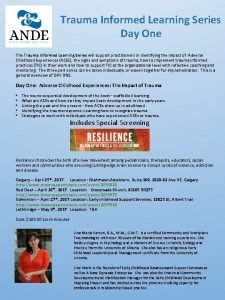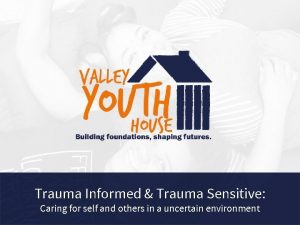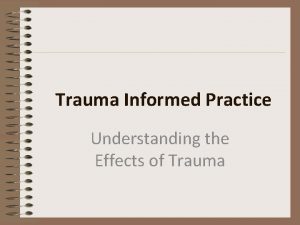Trauma Informed Care Veronika Kolder MD Updated April























- Slides: 23

Trauma Informed Care Veronika Kolder, MD Updated April 23, 2020 Thank you to Dr. Resmiye Oral for kindly sharing slides 5 - 8

Childhood maltreatment § § § Associated with higher risk of depression, chronic sleep disturbance, obesity, DM, substance use, cancer, CVD, sexual problems Early disruption of the social attachment bond in non-human primates causes long term effects on the neuro-chemical response to stress § increase in catecholamine response § effects on duration and extent of cortisol response § effects on serotonin system and endogenous opioid system PTSD characterized by § autonomic hyperactivity § intrusive re-experiencing § lack of habituation to acoustic startle § emotional numbing § Survivors may avoid making, cancel, or no-show for appointments, refuse exams, be unable to swallow pills, have intensely negative associations with bleeding, seek hysterectomy, or struggle after hysterectomy van der Kolk & Saporta, J Anx Research 1991; 4: 199 -212 Bates et al. The challenging pelvic exam. J Gen Intern Med 2011; 26(6): 651 -7 ACOG Committee Opinion 498: Adult manifestations of childhood sexual abuse, Aug 2011 Tudiver et al. Getting through Medical Examinations www. cwhn. ca/en/node/42905 Tudiver et al. Legacy of CSA in midlife women. Canadian Women’ Health Network, www. cwhn. ca/en/node/41877

Adverse Childhood Experiences (ACEs) http: //www. iowaaces 360. org/community. html § 55% of Iowans have at least one ACE § 14% of Iowans have 4+ ACEs § this applies to medical providers, too Prevalence A score of 4+ out of 10 is associated with a marked increase in adverse long-term health outcomes http: //acestoohigh. com/got-your-ace-score/ http: //www. iowaaces 360. org/ace-study. html Felitti et al Am J Preventive Med 1998; 14(4): 245 -58 ACE calculator available at http: //www. acestudy. org/ files/ACE_Score_Calculator. pdf

ACEs are common http: //www. cdc. gov/features/dsaces/index. htmll http: //acestoohigh. com/2012/10/03/the-adverse-childhood-experiences-study-the-largest-most-important-public-health-study-you-neverheard-of-began-in-an-obesity-clinic/ http: //acestoohigh. com/category/chronic-disease/page/2/

Prevalence of IHD, % Adverse Childhood Experiences vs. Ischemic Heart Disease ACE Score


Slide adapted with permission from Dr. Resmiye Oral, ACEs and Iowa, Grand Rounds lecture delivered 7 -15 -14 UIHC Dept Ob. Gyn THEORETICAL FRAMEWORK ONE EXAMPLE People with 6+ ACEs die nearly 20 years earlier on average than those without any ACEs. The more traumatic stress a person is exposed to over a lifetime, the greater the chances they will have elevated levels of inflammatory markers. Brown et al. , Am J Prev Med 2009; 37(5): 389 -96 National Center for Chronic Disease Prevention and Health Promotion O’Donovan et al. , Brain, Behav, Imm 2012 as discussed in SAMHSA Power. Point presentation of Dr. R. Almazar

Slide adapted with permission from Dr. Resmiye Oral, ACEs and Iowa, Grand Rounds lecture delivered 7 -15 -14 UIHC Dept Ob. Gyn ACEs & impact on Brain function • Affect regulation Panic reactions, depression, anxiety, hallucinations • Somatic issues • Sleep disturbances, severe obesity, pain • Substance use • Smoking, alcoholism, illicit drug use, IV drug use • Sexuality • Early intercourse, promiscuity, sexual dissatisfaction • Memory Amnesia (childhood) • Arousal • High stress, problems with anger, perpetrating domestic violence www. cw

Finding Your ACE Score While you were growing up, during your first 18 years of life: 1. Did a parent or other adult in the household often or very often… Swear at you, insult you, put you down, or humiliate you? or Act in a way that made you afraid that you might be physically hurt? Yes No If yes enter 1 ___ 2. Did a parent or other adult in the household often or very often… Push, grab, slap, or throw something at you? or Ever hit you so hard that you had marks or were injured? Yes No If yes enter 1 ___ older than you ever… Touch or fondle you or have you touch their body in a sexual way? or Attempt or actually have oral, anal, or vaginal intercourse with you? Yes No If yes enter 1 ___ No one in your family loved you or thought you were important or special? or Your family didn’t look out for each other, feel close to each other, or support each other? Yes No If yes enter 1 ___ You didn’t have enough to eat, had to wear dirty clothes, and had no one to protect you? or Your parents were too drunk or high to take care of you or take you to the doctor if you needed it? Yes No If yes enter 1 ___ 6. Were your parents ever separated or divorced? Yes No If yes enter 1 ___ Often or very often pushed, grabbed, slapped, or had something thrown at her? or Sometimes, often, or very often kicked, bitten, hit with a fist, or hit with something hard? or Ever repeatedly hit at least a few minutes or threatened with a gun or knife? Yes No If yes enter 1 ___ 8. Did you live with anyone who was a problem drinker or alcoholic or who used street drugs? Yes No 3. Did an adult or person at least 5 years 4. Did you often or very often feel that … 5. Did you often or very often feel that … 7. Was your mother or stepmother: 9. Was a household member depressed or mentally ill, or did a household member attempt suicide? Yes No Did a household member go to prison? Yes No If yes enter 1 ___ Now add up your “Yes” answers: This is your ACE Score. If yes enter 1 ___ 10.

Positive Responses to injury or ACEs Individual • Resilience • Post-traumatic growth Therapeutic • Trauma-Focused Cognitive Behavioral Therapy (TF-CBT) • Eye Movement Desensitization and Reprocessing (EMDR) Community/Political Resources: • Direct services Free 10 -page self-help guide, Dealing with the Effects of Trauma at Abuse & Mental Health Services Administration website • Victim compensation Substance http: //store. samhsa. gov/product/Dealing-with-the-Effects-of. Trauma-A-Self-Help-Guide/SMA-3717 • Reparation http: //childhoodtraumarecovery. com/2013/11/22/howposttraumatic-growth-relates-to-coping-strategies/ ACES Too High www. acestoohigh. com Centers for Disease Control and Prevention www. cdc. gov/ace Harvard Center on the Developing Child www. developingchild. harvard. edu Iowa ACEs 360 www. iowaaces 360. org Washington Family Policy Council www. fpc. wa. go Zero to Three www. zerotothree. org Last 6 references listed with permission of Dr. Resmiye Oral, ACEs and Iowa, Dept Ob. Gyn Grand Rounds lecture delivered 7 -15 -14 UIHC

Resilience Score Please circle the most accurate answer under each statement: Resilience TRUMPS ACEs 1. I believe that my mother loved me when I was little. Definitely true Probably true Not sure Probably Not True Definitely Not True 2. I believe that my father loved me when I was little. Definitely true Probably true Not sure Probably Not True Definitely Not True 3. When I was little, other people helped my mother and father take care of me and they seemed to love me. Definitely true Probably true Not sure Probably Not True Definitely Not True 4. I’ve heard that when I was an infant someone in my family enjoyed playing with me, and I enjoyed it, too. Definitely true Probably true Not sure Probably Not True Definitely Not True 5. When I was a child, there were relatives in my family who made me feel better if I was sad or worried. Definitely true Probably true Not sure Probably Not True Definitely Not True 6. When I was a child, neighbors or my friends’ parents seemed to like me. Definitely true Probably true Not sure Probably Not True Definitely Not True 7. When I was a child, teachers, coaches, youth leaders or ministers were there to help me. Definitely true Probably true Not sure Probably Not True Definitely Not True 8. Someone in my family cared about how I was doing in school. Definitely true Probably true Not sure Probably Not True Definitely Not True 9. My family, neighbors and friends talked often about making our lives better. Definitely true Probably true Not sure Probably Not True Definitely Not True 10. We had rules in our house and were expected to keep them. Definitely true Probably true Not sure Probably Not True Definitely Not True 11. When I felt really bad, I could almost always find someone I trusted to talk to. Definitely true Probably true Not sure Probably Not True Definitely Not True 12. As a youth, people noticed that I was capable and could get things done. Definitely true Probably true Not sure Probably Not True Definitely Not True 13. I was independent and a go-getter. Definitely true Probably true Not sure Probably Not True Definitely Not True 14. I believed that life is what you make it. Definitely true Probably true Not sure Probably Not True Definitely Not True How many of these 14 protective factors did I have as a child and youth? (How many of the 14 were circled “Definitely True” or “Probably True”? ) _______ Of these circled, how many are still true for me? _______ http: //www. resiliencetrumpsaces. org/providersin. cfm

Trauma Informed Care § Guiding principles § § Tread lightly First, do not harm http: //goneelvis. com/view/ § Paradigm switch § § § What we perceive as the problem (drinking, drug abuse, obesity, dissociation, sexual aversion problems) may actually be the solution ‘Dysfunctional behavior’ may actually be highly functional or adaptive behavior in light of past trauma It is adverse childhood experiences, not the intrinsic chemical properties of a substance, that determine how addicted a person becomes § Changing the question § § __________ What’s wrong with you? What happened to you? http: //www. cdc. gov/ace/index. htm Arias. Report from the CDC. J Women’s Health 2004; 13(5): 468 -73 2013 Trauma-Informed Approaches, Women, https: //s 3. amazonaws. com/static. nicic. gov/Library/027657. pdf

Trauma Informed care www. thenationalcouncil. org A hospital or clinic that is trauma-informed • realizes the widespread impact of trauma • understands potential paths for recovery • recognizes the signs and symptoms of trauma in clients, families, staff, and others • responds by fully integrating knowledge about trauma into policies, procedures, and practices • seeks to actively resist re-traumatization See also www. thenationalcouncil. org SAMHSA Draft Framework for Trauma-Informed Approaches


Triggers Suggested screening question: ‘Have you ever been the victim of a sexual or physical assault, military or civilian war-related violence, or a natural disaster? ‘ • Medical setting, interview, and exam can all represent triggers for survivors of abuse and result in – Intense anxiety – Flashbacks of prior fondling or penetration – Dissociation as a means of mental escape • Over 40% of childhood sexual abuse survivors report reexperiencing memories of earlier abuse during gynecologic evaluations • Once client answers ‘yes’, offer – – Additional longer visits Validated questionnaire for PTSD Referral to mental health services Patient education about PTSD Leeners et al. Psychosomatics 2007; 48(5): 385 -93, 389

TRAUMA-INFORMED GYN EXAM Consider the following when a client shares that she has been the victim of sexual abuse. I have also found this approach useful in females with intellectual disabilities. • Defer exam, return every 2 -4 weeks until as much of the exam as the client wants is completed • Provide detailed prep for exam, encourage client to discuss with her therapist, welcome presence of a support person • Collaborate with client to make a plan • Ask the client if there is anything you can do to make the exam easier for her • Suggest upright sitting position, offer mirror, let client insert her own speculum or guide provider hand • Offer topical anesthetic that client can apply to her fourchette, in private, before the exam • Consider a safe word that will mean ‘stop’, eg ‘wall’ • Offer to keep the TV on, it may be a welcome reminder of the here and now • Offer to say words or affirmations the client might find reassuring, eg ‘It is 2020, you are a capable adult, and you are taking care of your health’ • Offer options in draping, eg keeping on top, with bra removed, during breast exam; wearing own skirt with underwear removed for pelvic exam; delivering infant with scrub pants on that have crotch area cut out • Make a plan for what to do if she has a dissociative reaction, eg have a friend with her, call her therapist • Always have a chaperone • Gradual approach over the course of multiple visits, for example: • 1 st exam- performed dressed, head/neck/heart/lungs only • 2 nd exam- breast/abdominal exam • 3 rd exam- external genital exam only, with or without touch • 4 th exam- bimanual exam, one gloved finger • 5 th exam- speculum exam, consider 5/8 virginal speculum • 6 th exam- rectal exam • During the exam, allow the client to establish the pace • Stop if she • requests that you stop or says the safe word • appears distressed • is unable to • keep her eyes open • make eye contact when you request it • answer your questions • If the client has a dissociative reaction/is unable to talk normally with you after the exam, call her therapist +/or page a psychiatrist. It may take over an hour for her to ‘come around’ and she might require an observation admission. VK, 2020. See also White AA, Best practices for limiting risk of posttraumatic stress relapse during childbirth, thesis, 4 -1 -13 https: //repository. library. georgetown. edu/bitstream/handle/10822/558353/White_georgetown_0076 M_12065. pdf? s

Vaginal specula Berek & Novak’s Gynecology Vaginal specula 1. Graves extra long 2. Graves regular 3. Pederson extra long 4. Pederson regular 5. Huffman ‘virginal”, 5/8 th, adult ‘virginal’ 6. pediatric regular 7. pediatric narrow In general, the smallest speculum necessary to produce adequate visualization should be Used. When performing the first gynecologic exam on a patient who endorses a history of genital trauma or pain, consider asking the patient if she is able to insert a finger in her vagina. If she can, usually the Huffman 5/8 ths speculum can be inserted. If she doesn’t know, consider doing a digital exam with a gloved pinky finger first. If that is painless, try inserting a gloved first finger. I also suggest starting with a digital exam for patients who have had pelvic radiation therapy, radical hysterectomy, or brachytherapy. If the vagina is foreshortened, use a pediatric speculum. The obese patient is likely to require a longer speculum. When a speculum other than the standard Pederson is used, the patient should be informed so that she can remind the clinician before her next examination, and a note should be made in the record.

Chewable & liquid options Difficulty swallowing pills can be the result of abuse, medicationinduced xerostomia, or medical problems (eg. systemic sclerosis) Liquid SSRIs § Sertraline HC Oral Concentrate § § Fluoxetine Oral Solution § § 20 mg per 5 m. L; 120 m. L bottle, mint flavor Citalopram § § 20 mg per m. L; 12% alcohol, 60 m. L bottle, menthol scent 10 mg/5 ml; 150, 200, 225, 240, & 300 ml bottles Escitalopram § 5 mg/5 ml; 150, 240, 300, 450, 600 ml bottles Chewable contraceptive pills (wash down with 8 -ounce glass of any drink) § Femcon Fe® § § Generess® Fe § § norethindrone acetate 0. 4 mg / ethinyl estradiol 35 mcg norethindrone 0. 8 mg / ethinyl estradiol 25 mcg Minastrin® 24 Fe § norethindrone acetate 1 mg / ethinyl estradiol 20 mcg

Trauma-informed care resources • • • Maria Angeles Morcuende, MD Psychiatry PTSD, personality disorders Iowa Consortium for Mental Health, trauma focused cognitive behavioral therapy including workbook for children that some adults may also find helpful https: //www. healthcare. uiowa. edu/icmh/child/TF-CBT. htm Arizona State University, Center for Applied Behavioral Health Policy, https: //cabhp. asu. edu/professional-development/trauma-informed-care/resources Substance Abuse & Mental Health Services Administration, Dealing with the Effects of Trauma 10 -page free self-help guide http: //store. samhsa. gov/product/Dealing-with-the-Effects-of-Trauma-A-Self-Help. Guide/SMA-3717 National Center for Trauma-Informed Care, see Additional Tools http: //www. nasmhpd. org/TA/nctic. aspx – Understanding & addressing trauma in the lives of those we serve, Joan Gillece, Ph. D – Understanding the biopsychosocial impact of trauma, Brian R. Sims, MD Catherine Woodman, MD Psychiatry Anxiety, PTSD UI Stead Family Children’s Hospital, Child Protection Program – Anne Nielsen, ARNP; Erin Brown, ARNP, Kerstin Marnin, LMSW Wendy Shen, MD, Ph. D Family Medicine Erin Martin, DO Psychiatry Eating disorders Debra Suda, MD Psychiatry Helena Laroche, MD Internal Medicine Anne Gaglioti, MD Family Medicine Alice M. Fagin, MD Surgery Jill Endres, MD Family Medicine

UIHC staff with an interest in TIC Maria Angeles Morcuende, MD Psychiatry PTSD, personality disorders • Past members of the UIHC TIC Taskforce, previously under the direction of Resmiye Oral, MD Catherine Woodman, MD Psychiatry Anxiety, PTSD Erin Martin, DO Psychiatry Eating disorders Debra Suda, MD Psychiatry Helena Laroche, MD Internal Medicine Anne Gaglioti, MD Family Medicine Alice M. Fagin, MD Surgery Jill Endres, MD Family Medicine Wendy Shen, MD, Ph. D Family Medicine

Somatic symptom disorder § Diagnostic criteria § § ‘Canary in the coal mine’ History of side effects with all medications Dr. James Amos, UIHC staff psychiatrist with an interest in SSD § Therapeutic considerations § § Collaborate with mental health practitioner and PCP Return visits q 2 -4 months Cognitive behavioral therapy Pediatric dose SSRI § § Sertraline HC Oral Concentrate, 20 mg per m. L, 12% alcohol, 60 m. L bottle, menthol scent Fluoxetine Oral Solution, 20 mg per 5 m. L, 120 m. L bottle, mint flavor

LBGTQI services • Iowa River Landing LGBTQ clinic • Drs. Katie Imborek & Nicole Nisly. (Dr. Imborek also sees clients at UIHC Scott Blvd. Clinic) • Therapists welcoming transgender clients • • Peter Daniolos, MD Dept Psychiatry Autism, Pediatric Psychiatry & Psychology Kathryn (Kat) Nydan-Oleiver, LISW at community mental health (319) 338 -7884 Susan Fisher, Counseling Center Iowa City (319) 337 -6483 Cheryl Hetherington Ph. D, (319) 337 -9461 Kathy Cave, Ph. D, VAMC • LGBT youth • United Action for Youth – 338 -7518, ask for Talia Meidlinger, or one of the facilitators of the weekly LGBTQ youth group. Youth can meet a counselor for a few times without notifying parents. They can also enter shelter programs if homeless, or Oaks Youth Emergency Shelter • UIHC – Dr. Peter Daniolos, Department of Psychiatry, Pediatric Psychiatry – IRL LBGTQ clinic can see children ages 10 and up. Ask for Dr. Katie Imborek, MD with Four Katie Imborek, MD Dept Fam Med LGBTQ Clinic • Intersex and Turner’s infants • Peds genetics, Dr. Olig Shchelochkov, pager 8077 • Peds endocrine, Dr. Katie Larsen Ode – Turner’s kids are usually followed by Peds Endocrine – Dr. Larsen Ode may also be willing to meet with parents to address what they can anticipate when the diagnosis is made prenatally https: //doi. org/10. 1016/j. jadohealth. 2009. 12. 029 Nicole Nisly, MD Dept Int Med LGBTQ Clinic Complementary & Alternative Med

Therapists (alphabetically by last name) • Arwa Aburizik, MD – Double boarded in internal medicine and psychiatry with focus on oncology • Nashae ‘Nikki’ Julian, Ph. D – Counselor educator in private practice, focus on trauma-informed care and sexual health • Amy Stockman, Ph. D – Experienced health psychologist in private practice at Anderson Arnold Associates, Iowa City • Janeta Tansy, MD – Integrative psychiatrist in private, cash-only, practice
 4 r's trauma informed care
4 r's trauma informed care Trauma-informed care activities for staff
Trauma-informed care activities for staff Lgbtq trauma informed care
Lgbtq trauma informed care Www.dfps.state.tx.us/training/trauma informed care/
Www.dfps.state.tx.us/training/trauma informed care/ Trauma informed care for foster youth
Trauma informed care for foster youth 4 r's trauma informed care
4 r's trauma informed care Sensory modulation
Sensory modulation 4 r's trauma informed care
4 r's trauma informed care Trauma informed practice
Trauma informed practice 4 r's trauma informed care
4 r's trauma informed care Kolder humor
Kolder humor Trauma informed parenting discipline
Trauma informed parenting discipline Trauma-informed questions for clients
Trauma-informed questions for clients Trauma informed practice
Trauma informed practice Jennifer masi
Jennifer masi Trauma infromed
Trauma infromed Trauma informed advising
Trauma informed advising Kobtion
Kobtion Trauma informed practice
Trauma informed practice Trauma-informed workplace checklist
Trauma-informed workplace checklist During _______ branching, only car is updated with adr
During _______ branching, only car is updated with adr Phases of rpms
Phases of rpms Primary secondary tertiary medical care
Primary secondary tertiary medical care Dshs uncompensated trauma care application
Dshs uncompensated trauma care application
